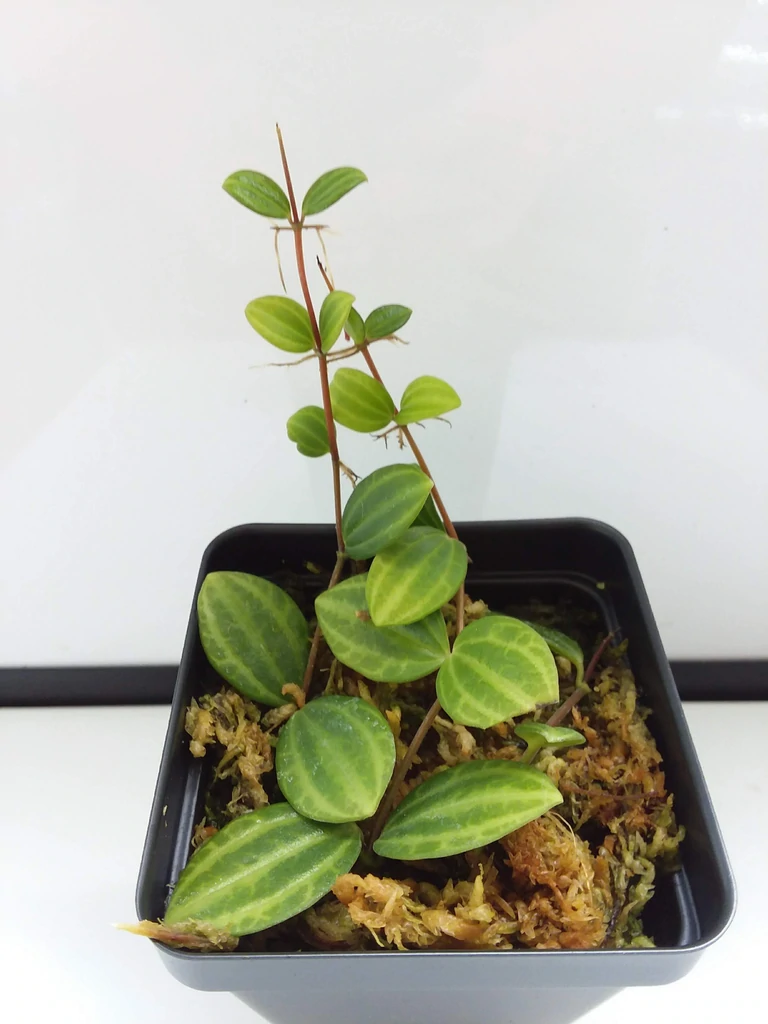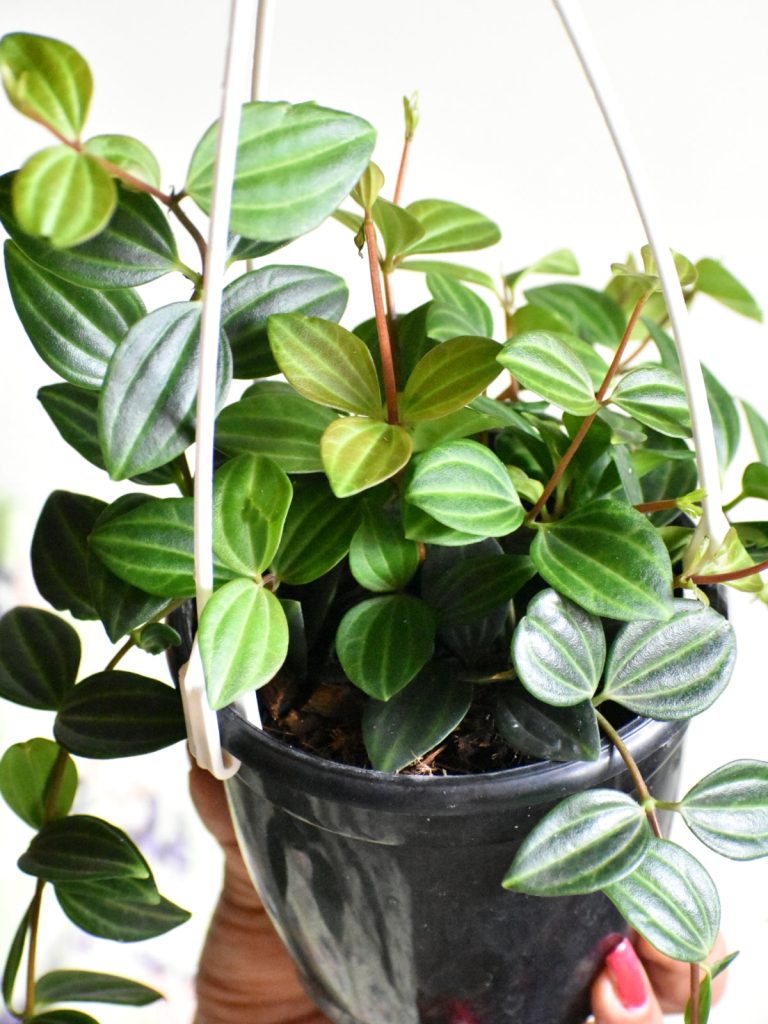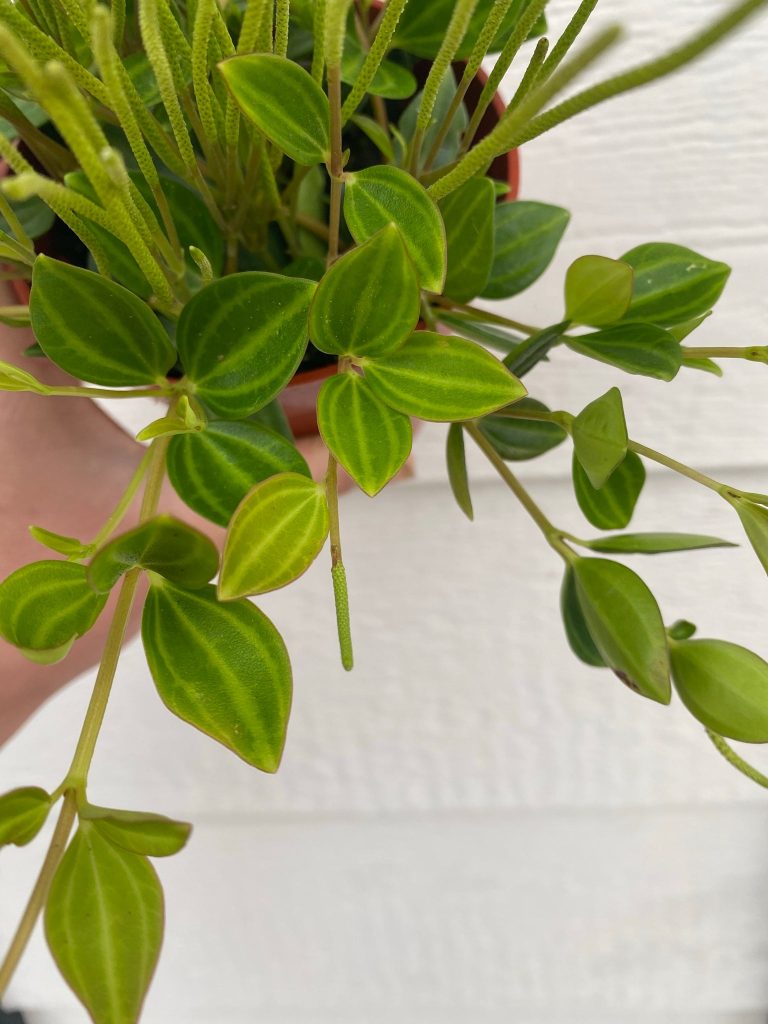The peperomia quadrangularis is a stunning plant, especially loved by lovers of plants in hanging stems, the plant has beautiful stems, and they look dashing when as they trail down the hanging pots.
Contrary to some years back when the plant was rare, and it was not found everywhere, however now, a lot of gardeners and plant lovers and coming to know and special peperomia variety.
Learning to grow the peperomia quadrangularis includes learning to identify it, this is because many variants look close to this, the difference between this plant and others is that its stem has four sides, hence you will be required to touch it to know it.
The quadrangularis is a slow-growing plant and requires patience alongside other important tips to grow properly. This peperomia quadrangularis care and propagation guide have been compiled to help you have a smooth sail growing your lovely plant.
Peperomia Quadrangularis explained
The peperomia quadrangularis is also known by common names such as beetle peperomia, radiator plant, and peperomia angulata. The plant is a tropical perennial shrub, with origin from South America, specifically in Brazil and Panama.
Peperomia quadrangularis is known and loved for its dark green variegated foliage.
The leaves are oblong-shaped and have golden lines that complement them when placed in hanging baskets. Oftentimes, the plant is grown as a ground cover plant, however, in recent times; it is commonly grown as a houseplant, either in a pot or in hanging baskets.
Peperomia quadrangularis can grow to 12 inches in size, when trailing, with the leaves’ growth reaching 1 inch in length. It will grow faster when on the ground than when placed in pots.
| Common name | Beetle peperomia, radiator plant, peperomia angulata |
| Scientific name | peperomia quadrangularis |
| Plant type | tropical perennial shrub |
| Plant genus | piperaceae |
| Light | Bright indirect light. |
| Soil type | Well draining soil |
| Temperature | Above 59 degrees F |
| Soil pH | 5.5 to 6.5 |
| Native | South America |
| Toxicity | Non-toxic |
Peperomia Quadrangularis Propagation

For us, we believe that propagation is a time to get engaged with your plant, hence can be fun for you. It is also a time to prepare gifts for your family and friends if they are plant lovers.
Propagating the peperomia quadrangularis is no different from the rest of its family; the plant is best propagated via stem cutting and leaf cutting. We will show you how to go about it!
Needs For Propagation
- A healthy and mature plant
- Well draining potting mix
- Sterilized shears or knife
- Rooting hormones(optional)
- Pot
1. Leaf-Cutting
- Make your leaf cutting, with the shears or knife from a healthy mother plant. You can cut out as many leaves as you will like to propagate.
- Dip the stem of the leaves in rooting hormones and let it dry out. Please note that your plant will grow with or without the rooting hormones.
- Afterward, prepare your soil in a pot with good drainage holes. Make sure the soil you are using is well-draining and light. Place the leaves into the already prepared soil in a pot. We suggest that the leaves are 4 inches apart from one another.
- Press the soil around each leaf to ensure that the leaf is firmly in the soil. Water the plant, once a day for three days, you can do this using a spray bottle.
- Cover the tray or pot with a plastic bag, to retain moisture and create humidity for your plant.
- When you notice your plant is developing new leaves, you can then transplant them into their pots.
2. Stem Cutting
- From a healthy and mature mother plant, identify a healthy stem, free of bugs or any fault, and cut out below the stem node.
- Prepare your potting mix that is suitable for this plant and bury the stem cutting into the potting mix. For faster rooting, you can dip the tip of the stem in a rooting hormone, however, that isn’t necessary.
- After placing your plant into the pot, water it and place it in shaded spots for some days. After some weeks, your plant will develop its root.
- Once the plant is fully rooted, it can be transplanted into a bigger pot.
Peperomia Quadrangularis Care Guide
Although caring for your plant seems simple, a lot of people, unknowingly, make life-threatening mistakes with some of their care routines. The following guide will teach you just how to care for your plant the right way, and also help you strike a balance between overdoing it and underdoing it.
1. Light
To keep its colors and beauty, the peperomia quadrangularis will appreciate being provided sufficient light. Keep in mind that these plants are outdoor plants; hence they love their environment to be well-lit. However, they cannot tolerate being placed where the direct rays of the sun will hit them.
We recommend that you expose them to bright, indirect, or filtered light throughout the day. Ensure that they are not placed in the shade as this will make them lose their color, variegation, and beauty.
If you find your plant to be pale, yellow with few leaves, as well as a leggy stem, it is an indication that your plant isn’t receiving as much light as it should. You can place these plants by the south, west, or east window during the day.
If you will be growing them outdoor, you should place them behind other plants, the other plants will filter the sun before it gets to the quadrangularis.
2. Water
The peperomia quadrangularis will not appreciate overwatering or under-watering. The good thing is that this plant is similar to succulent, which means it can store water in its leaves and stem, hence you can water it as one. It also loves rainwater and likes that its soil is kept moist but not soggy.

Water your peperomia quadrangularis plant in small quantities like a succulent, do this with some stored rainwater. How to identify the perfect time to water your plant, stick your finger into the soil, if the top 2 inches of soil is dry, then your plant is ready to be watered.
Generally, it is suggested that your plant be watered once a week. Similar to other plants, your plant should be watered more in the summer and less in the winter. If you find your plant to be wilting, it is an indication that your plant is under-watered. You should observe and adjust its watering schedule.
3. Soil
Similar to other epiphytes in the tropics, the peperomia quadrangularis gets its nutrients from the air, water, and wood bark. However, this should not make you grow them in just any soil. The plant will appreciate growing in soil pH of 5.5 to 6.5.
It also grows best in moist and well-drained soil, to achieve this, we suggest that you prepare a soil mix with enough organic matter to help its growth process.
A combination of peat moss, compost, mulch, and orchid bark will give the plant all it needs in the soil to grow. An addition of perlite will help work on the drainage.
4. Humidity
Peperomia quadrangularis, like many other plants from the tropics, loves to be provided with enough humidity.
This plant enjoys and needs more humidity to grow, remember that it gets its nutrients from the air. To ensure that your plant has the right measure of humidity, there are alternatives that you can employ to get this.
Most notably, keeping your plant close to other plants will increase the humidity level and mimic the tropics. Also, placing your plant on pebble trays will work well in creating humidity. Misting your plant can also help in maintaining humidity.
5. Temperature
These plants grow well in warm temperatures. Its love for warm weather earned it the name radiator plant. The plant should be grown at a temperature above 59 degrees F; anything below this can hinder the growth of the plant. Placing it in frost during winter will kill it, keep the plant away from heaters, air conditioners, etc.
6. Fertilizer
When provided with the right soil, water, and great humidity, this plant will grow properly, however, it is suggested that you feed them light fertilizer in the growing months. Feed them monthly during this time with the use of organic fertilizer.

Do not fertilize in winter, as this is their dormancy stage. You can also make organic fertilizer in your home, however, ensure it has the important nutrients; nitrogen, phosphorus, and potassium.
Peperomia Quadrangularis Growing Tips
Here are some additional growing tips to keep in mind when propagating Peperomia Quadrangularis at home.
- Pruning the plant is good, however, it should be light, heavy pruning can damage the plant.
- Cut off damaged or dead leaves and stem to keep the others healthy and fine.
- These plants have a shallow root system; hence they can grow well in one pot for many years.
- The best time to propagate is at the beginning of growing seasons, and the best time to repot is in the winter.
- A change in the colour and looks of your plant is an indication that something has gone wrong with the care guide, we advise that you observe your plant and adjust appropriately.
- The peperomia quadrangularis growth ranges from slow-growing to moderately growing. You must exercise patience when growing this plant.
- Bugs and pests may frequent your plant from time to time, however, it’s nothing an organic insecticide cannot get rid of.
- Less watering and adequate light will keep your plant happy.
- The best type of pot to use for your peperomia quadrangularis is a terracotta pot.
FAQs
Why Are The Leaves Of My Peperomia Quadrangularis Fading?
Is Peperomia Quadrangularis A Succulent?
How Often Should I Water My Peperomia Quadrangularis?
Can I Grow Peperomia Quadrangularis Under Artificial Light?
Should I Mist My Peperomia Quadrangularis?
Final Thoughts
Peperomia quadrangularis is a good plant to keep in the home or surroundings.
However, it requires proper care and attention to grow well. During propagation, we suggest that you do not check your plant often for roots, let it be for 3 to 4 weeks as checking it often will reduce its chance of success.
More peperomoa guides:
